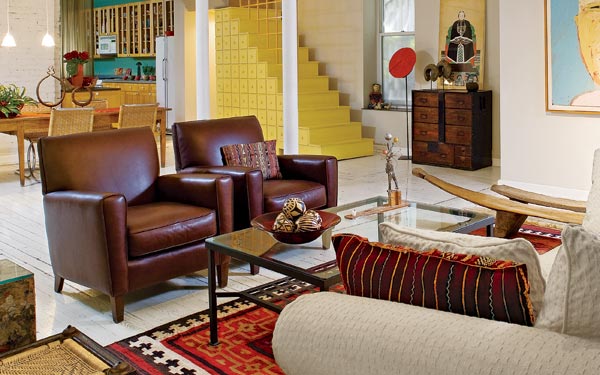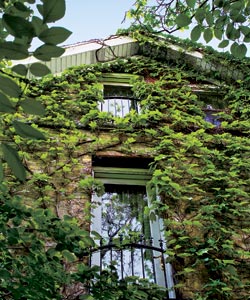
In the living area, wood chaises from West Africa and camp chairs from India add edge to a contemporary sofa and chairs from Room & Board. Take photo tour >>
Why delay the inevitable? When I begin my interview with Nancy Bush, a real-estate developer who lives in a rehabbed property of her own reinvention in Wicker Park, the first question is, Are you related to President Bush? She brings more bluntness to this answer than she does to other queries. "No, no," she says. "I had that problem with the first Bush, but now it’s even more embarrassing. I’ve looked it up genealogically, and the answer is no."
In the mid-nineties, though, when Bush (as in Nancy) looked at the property where she lives now, her initial response was just as dismissive. Without even completing a tour of the two conjoined late-19th-century brick buildings—the one in front was formerly a grocery store—she left, discouraged by the degree of decline. Later, driving around in search of the right site, she noticed that the property was still for sale. Since Bush planned to gut the space anyway, she reasoned, it didn’t matter if it was a wreck. And, besides, she knew what she was doing. After earning a bachelor’s degree in architectural design, she had worked for the Chicago architect Laurence Booth for two years and then went back to school for an MBA. In the early nineties, after careers in real-estate investment and corporate development, she decided to take a year off and then opted for an independent life.
"I’ve never made as much money as I did then, but the freedom is worth it," Bush says. She started her own business, buying, rehabbing, and selling properties. Recently, in Bridgeport, Mayor Daley’s former home turf, she renovated a cottage and converted a warehouse into two lofts. "Bridgeport is still affordable," Bush says. "Artists have moved in, and all the industrial buildings have gone condo."
She had been living in a loft in River North for 17 years when she decided to make her own move. She wanted a garden, and the Wicker Park property was ideal for that. It was at ground level and was a lot and a half wide and an extra seven feet deep—an inner-city luxury, a generous slice of blacktopped land that within a few years she would transform into a shaded woodland.
The exterior of Bush’s building gives away nothing. At some point, a storefront was added, but even with ivy climbing across the façade and cascading down, the place looks deserted. So once inside, a visitor is surprised by the openness of the space and its quirky exoticism, by the expansive view that goes straight through on the first floor from the entrance hallway to the garden. It’s clear that Bush is at home here and that she knows how to have a good time.
She took on the general-contracting responsibilities for the rehab; after all, that’s her business. In the end, Bush, who is single, would have a one-bedroom house with a small rental apartment on the second floor. Paul Florian, the principal of Florian Architects and a friend of Bush’s, advised on spatial concepts. "Nancy is very sophisticated, and she knows what she wants," Florian says. "She’s excellent to work with that way. Her taste is eclectic, and she loves big, simple spaces. She likes things a bit rustic; she doesn’t want things to look designed. She likes them to feel as if they happened over time, as if there’s a sense of history to them."
|
|
Bush’s office is in front, beside the storefront windows, now in pebbled glass that ensures privacy but allows in ample light. Partial walls in yellow gold and red were inspired by trips to Guatemala, where in 2003 Bush bought a 17th-century church, someday to be a second home. In front of the windows, she built a tiled garden enclosure with a small fountain. She glides easily in this space. "I love to zoom around in my office chair to my filing cabinets or my drafting table," she says. This is a lighthearted place to work, and the bougainvillea here starts blooming in February.
A wall in Persian red leads past a black powder room and into the large living and dining area. Perpendicular to the wall is a dramatic backdrop of cold-rolled steel draped with an intricate Islamic weaving from the Douglas Dawson Gallery; it was originally part of a bride’s dowry. A sofa covered in cream fabric and two chocolate leather chairs from Room & Board form the center of the seating area. In between is an antique kilim. On either side of the grouping are a pair of slender wood chaises from Burkina Faso in West Africa and two Rajasthani camp chairs.
The French country dining table came years ago from an interior decorating shop once owned by Bush’s mother. More than 12 feet long, a solid rectangle, it took Bush a while to find a space that could accommodate it. For contrast, she surrounded it with chairs by Mies van der Rohe. Their frames are tubular steel; the seats and backs, woven cane.
On the right is an illusionist’s marvel. Most of the staircase leading up to the second floor and the attic is built in, but the lower section is a freestanding piece of furniture painted in pale lemon. Bush based its design on that of a stepped Japanese cabinet. The back opens to reveal a closet. Some of the square drawers on the side open; others are faux and join to make cabinet doors. A steel grid in orange extends from a wall and the ceiling to form a railing.
The room in back, with walls in a deep garden green, is a combined kitchen and library— a comfortable place where Bush can nourish her body and her mind. She decided not to have the glass installed in the doors of the maple kitchen cabinets—in another seemingly magical illusion, she simply reaches through the open spaces for whatever she wants to retrieve. The countertops are a patinaed zinc; the windowsills are covered in cold-rolled steel—the effect is arty, industrial, refreshingly primitive. Custom-made bookshelves line the wall opposite the kitchen between windows that offer glimpses of birds in flight.
French doors open to the garden, where Bush and friends gather on summer evenings. "There was nothing here 12 years ago, except for the catalpa tree, which is this great, big thing," Bush says. She had the blacktop removed, fenced in the yard, and added a garage. "The first year, I planted trees," she recalls. "The second year, I planted shrubs, and the third year, I planted the stuff on the ground." Now she has yellowwood trees, a Japanese maple, Arnold Promise witch hazel (another February bloomer), yews, boxwoods, and a giant leather-leaf viburnum. In back are a peony patch and an herb and vegetable garden.
A stone path leads to a hidden outdoor room with a hammock and chairs, but Bush and her guests usually lounge around on the patio within sight of a small pond. "It’s always cooler back here," Bush says of the garden. "It makes it a little oasis, and I love having the dense shade." When darkness descends, she lights the lanterns dangling from tree branches, and solar-powered stars on stakes twinkle in the night.
Resources >>>
Photography: Barbara Karant; Styling: Diane Ewing




